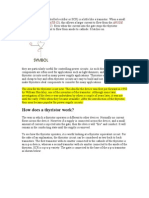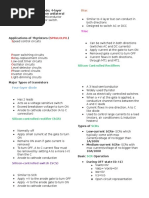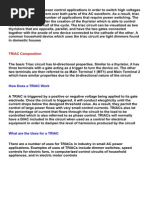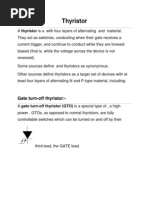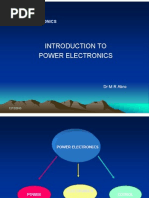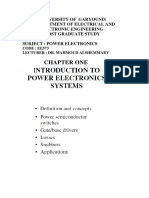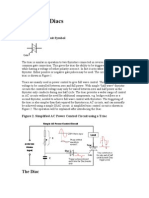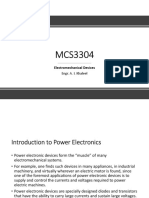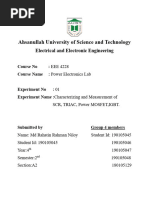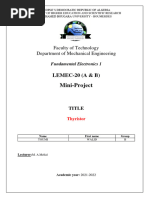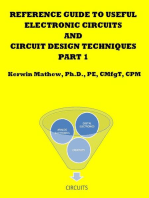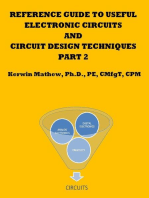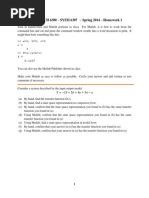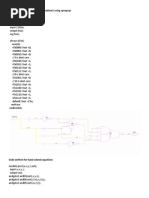TRIAC
TRIAC
Uploaded by
Gowtham HariCopyright:
Available Formats
TRIAC
TRIAC
Uploaded by
Gowtham HariOriginal Description:
Copyright
Available Formats
Share this document
Did you find this document useful?
Is this content inappropriate?
Copyright:
Available Formats
TRIAC
TRIAC
Uploaded by
Gowtham HariCopyright:
Available Formats
TRIAC
TRIAC, from Triode for Alternating Current, is a genericized tradename for an electronic component that can conduct current in either direction when it is triggered (turned on), and is formally called a bidirectional triode thyristor or bilateral triode thyristor. TRIACs belong to the thyristor family and are closely related to Silicon-controlled rectifiers (SCR). However, unlike SCRs, which are unidirectional devices (i.e. can conduct current only in one direction), TRIACs are bidirectional and so current can flow through them in either direction. Another difference from SCRs is that TRIACs can be triggered by either a positive or a negative current applied to its gate electrode, whereas SCRs can be triggered only by currents going into the gate. In order to create a triggering current, a positive or negative voltage has to be applied to the gate with respect to the A1 terminal (otherwise known as MT1). Once triggered, the device continues to conduct until the current drops below a certain threshold, called the holding current. The bidirectionality makes TRIACs very convenient switches for AC circuits, also allowing them to control very large power flows with milliampere-scale gate currents. In addition, applying a trigger pulse at a controlled phase angle in an AC cycle allows one to control the percentage of current that flows through the TRIAC to the load (phase control), which is commonly used, for example, in controlling the speed of low-power induction motors, in dimming lamps and in controlling AC heating resistors.
POWER MOSFET
A power MOSFET is a specific type of metal oxide semiconductor field-effect transistor (MOSFET) designed to handle significant power levels. Compared to the other power semiconductor devices, for example IGBT, Thyristor, its main advantages are high commutation speed and good efficiency at low voltages. It shares with the IGBT an isolated gate that makes it easy to drive. It was made possible by the evolution of CMOS technology, developed for manufacturing Integrated circuits in the late 1970s. The power MOSFET shares its operating principle with its low-power counterpart, the lateral MOSFET. The power MOSFET is the most widely used low-voltage (that is, less than 200 V) switch. It can be found in most power supplies, DC to DC converters, and low voltage motor controllers.
BJT
You might also like
- ThyristorsDocument4 pagesThyristorssanal89No ratings yet
- Seminar Topic On Speed Control of DC Motor Using TRIACDocument18 pagesSeminar Topic On Speed Control of DC Motor Using TRIACRicha0001100% (1)
- Thyristor TypesDocument5 pagesThyristor TypesMustafa AnwarNo ratings yet
- 10.1 S06L06-ThyristorDevices - PDF - (FreeCourseWeb - Com)Document14 pages10.1 S06L06-ThyristorDevices - PDF - (FreeCourseWeb - Com)yotopia horoor gameNo ratings yet
- Heavy CurrentDocument26 pagesHeavy CurrentKobby BrineNo ratings yet
- Triac Symbol and Construction: MT MT G MTDocument2 pagesTriac Symbol and Construction: MT MT G MTRonsonel TajanNo ratings yet
- How Does A Thyristor Work?: G A Cathode CDocument10 pagesHow Does A Thyristor Work?: G A Cathode Csamith1No ratings yet
- 2,scDocument7 pages2,scmukhoaritra69No ratings yet
- Lec-1 (Introduction To Power ElectroDocument37 pagesLec-1 (Introduction To Power ElectroEngr Muhammad Faisal YaqoobNo ratings yet
- Sprelolpil S: P Re LDocument8 pagesSprelolpil S: P Re LgoodNo ratings yet
- TRIACDocument5 pagesTRIACSaumil KarnadNo ratings yet
- Power ElectronicsDocument9 pagesPower Electronicsakshatha bhatNo ratings yet
- Electronic Devices Used in Power Electronics Characteristics ComparisonDocument12 pagesElectronic Devices Used in Power Electronics Characteristics ComparisonEysha qureshiNo ratings yet
- Lecture 1Document38 pagesLecture 1insolacNo ratings yet
- Triac Tutorial and Triac Switching CircuitsDocument8 pagesTriac Tutorial and Triac Switching CircuitsNikšaNo ratings yet
- Rich Text Editor FileDocument1 pageRich Text Editor FilefranchmaverickNo ratings yet
- EE62 Lab 1 - JEFFER N. FALLARCUNADocument8 pagesEE62 Lab 1 - JEFFER N. FALLARCUNAJeffer FallarcunaNo ratings yet
- Electronic SwitchesDocument18 pagesElectronic SwitchesGino Fabillar NacuaNo ratings yet
- Simulation of Power Electronic Converters Using Matlab SimulinkDocument19 pagesSimulation of Power Electronic Converters Using Matlab SimulinkajithNo ratings yet
- Thyristor Triacand DiacDocument12 pagesThyristor Triacand DiacNadin NirvanaNo ratings yet
- Power Semiconductor Device - Wikipedia, The Free EncyclopediaDocument5 pagesPower Semiconductor Device - Wikipedia, The Free EncyclopediaVaishnavi BalakrishnanNo ratings yet
- Tria C Principle Structure Working With Application CircuitsDocument14 pagesTria C Principle Structure Working With Application CircuitseuginephilipwagudeNo ratings yet
- TriacDocument3 pagesTriacMuhd Zulhusni Ag JaludinNo ratings yet
- Industrial Electronics Assignment #2 Silicon Controlled Switch (SCS)Document8 pagesIndustrial Electronics Assignment #2 Silicon Controlled Switch (SCS)LM BecinaNo ratings yet
- Thyristor: (Silicon-Controlled Rectifier)Document25 pagesThyristor: (Silicon-Controlled Rectifier)lalitcool8No ratings yet
- Power Electronics - 2 Books For An Open WorldDocument10 pagesPower Electronics - 2 Books For An Open WorlddcasdcNo ratings yet
- Chapter-3Document13 pagesChapter-3Bts ArmyNo ratings yet
- Switching DevicesDocument14 pagesSwitching Devicesleonardo_arévalo_28No ratings yet
- PWM Based Induction Motor Control - 1Document25 pagesPWM Based Induction Motor Control - 1jagannathpressbdkNo ratings yet
- SCR Triac, BJT)Document17 pagesSCR Triac, BJT)Nadhirah YusofNo ratings yet
- Rashid BookDocument12 pagesRashid BookShazleena ShareefNo ratings yet
- Thyristor: Gate Turn-Off ThyristorDocument24 pagesThyristor: Gate Turn-Off ThyristorchsibiNo ratings yet
- DIACDocument11 pagesDIACyudha ainurrokhimNo ratings yet
- Thyristor Triac and Diac PDFDocument12 pagesThyristor Triac and Diac PDFhari.bvmNo ratings yet
- TRIACDocument10 pagesTRIACJemima ANo ratings yet
- 13 4 7inverterDocument9 pages13 4 7inverterSa'id Ibn Mas'udNo ratings yet
- Advancements in P.esDocument30 pagesAdvancements in P.esSifar TeenNo ratings yet
- Triac QuadrantDocument15 pagesTriac QuadrantJohn Paul BaquiranNo ratings yet
- Transistor and Voltage DividerDocument10 pagesTransistor and Voltage DividerAya SaleemNo ratings yet
- What Is The Power ElectronicsDocument16 pagesWhat Is The Power ElectronicsashammoudaNo ratings yet
- Triacs and Diac1Document4 pagesTriacs and Diac1Shamsul Haq NtcNo ratings yet
- MCS3304 4Document11 pagesMCS3304 4Muhammad Ibrahim IsahNo ratings yet
- SCR ProtectionDocument24 pagesSCR Protectionasvijoriya111No ratings yet
- Triac Tutorial and Triac Switching CircuitsDocument7 pagesTriac Tutorial and Triac Switching CircuitsErick Perez100% (1)
- Temperature Control Utilizing SSRDocument2 pagesTemperature Control Utilizing SSRAtakan OzturKNo ratings yet
- AST 117 - Industrial Power ElectronicsDocument25 pagesAST 117 - Industrial Power ElectronicsKrieczek DoyuganNo ratings yet
- Overview of SsrsDocument3 pagesOverview of SsrsDavid MartinNo ratings yet
- Alternating Currents Zero Cross: Synchronously Fully OnDocument4 pagesAlternating Currents Zero Cross: Synchronously Fully OnDianne Claudinne MapanooNo ratings yet
- Transistor&IcDocument66 pagesTransistor&IcmythonyNo ratings yet
- Power ElectronicsDocument201 pagesPower Electronicsdream breakerNo ratings yet
- EEE4248 Exp1 Group4Document14 pagesEEE4248 Exp1 Group4Mohsin Islam RifatNo ratings yet
- LEMEC-20 (A and B) - Cover PageDocument5 pagesLEMEC-20 (A and B) - Cover PageWalid ToumiNo ratings yet
- Class PEDocument90 pagesClass PEAlex WaxanNo ratings yet
- Speed Control of Three-Phase Induction Motor by using Ac-ChopperDocument38 pagesSpeed Control of Three-Phase Induction Motor by using Ac-Chopperعبدالله نعمان آلزبيديNo ratings yet
- Induction MotorDocument6 pagesInduction MotorHamdani RizkiNo ratings yet
- Triacs and DiacsDocument4 pagesTriacs and Diacsssami670No ratings yet
- Supplementary Components and System: Engr - Kashif IqbalDocument21 pagesSupplementary Components and System: Engr - Kashif IqbalHassan Bin QasimNo ratings yet
- Reference Guide To Useful Electronic Circuits And Circuit Design Techniques - Part 1From EverandReference Guide To Useful Electronic Circuits And Circuit Design Techniques - Part 1Rating: 2.5 out of 5 stars2.5/5 (3)
- Reference Guide To Useful Electronic Circuits And Circuit Design Techniques - Part 2From EverandReference Guide To Useful Electronic Circuits And Circuit Design Techniques - Part 2No ratings yet
- Aoi 22Document6 pagesAoi 22Bryan OrenseNo ratings yet
- Scan Path DesignDocument54 pagesScan Path DesignGowtham HariNo ratings yet
- VLSI Questions Answers r3Document79 pagesVLSI Questions Answers r3Gowtham HariNo ratings yet
- Unix CommandsDocument4 pagesUnix CommandsAzmat NaseemNo ratings yet
- EE/CE 6301: Advanced Digital Logic: Bill SwartzDocument140 pagesEE/CE 6301: Advanced Digital Logic: Bill SwartzGowtham HariNo ratings yet
- EE 6325 VLSI Design: Office HoursDocument5 pagesEE 6325 VLSI Design: Office HoursGowtham HariNo ratings yet
- HW 1Document1 pageHW 1Gowtham HariNo ratings yet
- EEDG/CE 6301: Advanced Digital Logic: Mehrdad NouraniDocument44 pagesEEDG/CE 6301: Advanced Digital Logic: Mehrdad NouraniGowtham HariNo ratings yet
- Problem 3) Implementation of Problem1 Using Synopsys CodeDocument22 pagesProblem 3) Implementation of Problem1 Using Synopsys CodeGowtham HariNo ratings yet
- Chapter 1. Overview of Digital Design With Verilog HDLDocument6 pagesChapter 1. Overview of Digital Design With Verilog HDLGowtham HariNo ratings yet
- Digital Microelectronic Digital Microelectronic Circuits Circuits ( (Document24 pagesDigital Microelectronic Digital Microelectronic Circuits Circuits ( (Gowtham HariNo ratings yet
- Introduction To Analog Integrated Circuits DesignDocument20 pagesIntroduction To Analog Integrated Circuits DesignGowtham HariNo ratings yet
- Power Electronics1Document19 pagesPower Electronics1Gowtham HariNo ratings yet






